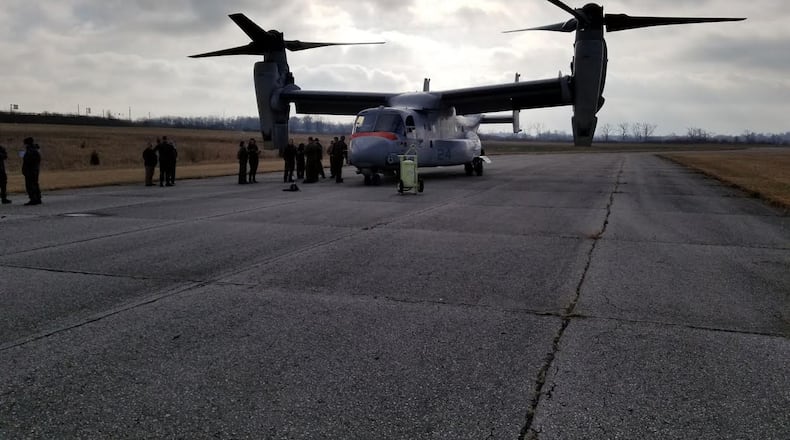RELATED: Wright-Patterson home to world’s most advanced centrifuge
“There’s no substitute to understanding how a human being integrates into an aircraft without the actual aircraft,” Lee said in an interview with this newspaper. “I’d love to say that virtual reality has advanced to the point that we don’t need physical aircraft, but we’re not there yet.
“The big thing with this aircraft (is) because this tilt-rotor technology is unique, it puts unique pressures on the body,” Lee said. The Osprey adjusts its twin propellers to take off and land like a helicopter and fly like a conventional airplane.
RELATED: Massive 270,000-pound aeromedical device comes to Dayton
The plane landed Tuesday at the airstrip next to the National Museum of the U.S. Air Force at Wright-Patterson. The aircraft arrived from Naval Air Station Patuxent River in Maryland, the end of nearly 15 years of experimental flight testing, including three winters in the Canadian province of Nova Scotia.
The tilt-rotor turboprop will be rolled into a hangar at the Air Force School of Aerospace Medicine. The engines and other parts of the plane will be removed. Aviation medical personnel at the school will train to load patients into the Osprey in a dual use of the unique airplane, Lee said.
The Navy’s interest is finding out how injuries occur to crew members aboard the aircraft, which will be a “workhorse” transporting troops in the Marine Corps for decades, according to Lee.
RELATED: Wright Patt researchers search for clues on F-35 stealth fighter issue
The Ohio State University Spine Research Institute will work with the Navy on ergonomic research aboard the ground-based MV-22, Lee said.
“One of the major medical complaints of aircrew is neck and back pain,” he said. “If we can mitigate that, provide either changes to the aircraft itself or how people move within the aircraft, that can significantly mitigate musculoskeletal stress and back pain injury.”
The tilt-rotor has other uses within the military:
The Navy plans to fly CMV-22B planes, which costs $88.9 million today, to haul passengers and cargo to aircraft carriers at sea by the 2020s.
The Air Force’s $90 million version, called the CV-22, flies in the service branch’s Special Operations Command.
The MV-22 is the first aircraft the Navy research unit has brought to Wright-Patterson, Lee said. The unit relocated from the Naval Air Station in Pensacola, Fla., several years ago.
About the Author
